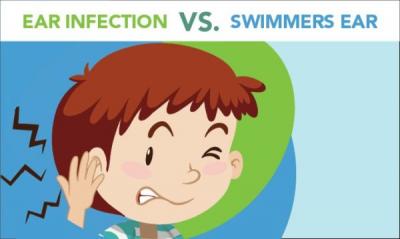Swimmer's Ear
Swimmer’s ear, or “otitis externa,” is an irritation of the ear canal (the connection between the outer ear and the eardrum) that can develop after frequent swimming or exposure to water. Water entering the ear can flush out the body’s protective ear wax, leading to infection with bacteria.

This is different from a classic ear infection, or “otitis media”, in which the infection is behind the ear drum itself. The type of infection your child has can be determined by your healthcare provider.

Swimming is not the ONLY risk factor for developing otitis externa. Frequent use of Q-tips to clean the ear may irritate the canal, and/or remove protective ear wax. The saying, “don’t put anything smaller than your elbow inside your ear” is actually true! (On rare occasions, however, ear wax may need to be removed by a medical professional, so that we can visualize the ear drum, or to relieve pain from impacted wax).
Symptoms of swimmer’s ear may include:
- Pain to the outer ear
- Itchiness
- Fluid draining from the ear
- Trouble hearing
Tips to prevent swimmer’s ear:
- Shaking out the ears after swimming
- Swimming with earplugs
- Older children can blow dry their ears on the low setting, keeping the dryer 1 foot away from their ears.
- Avoid inserted Q-tips inside the ear canal
Swimmer’s ear can usually be treated at home, with ear drops prescribed by your provider, and with over-the-counter pain medication.
Watch the video below of Dr. Neidig showing how to administer ear drops for children of different ages.
Steps for administering ear drops in children:
- Warm the ear drop vial in your hands for 1-2 minutes
- Have your child lay down on their side, with the affected ear facing upwards.
- If your child needs help holding still, have someone else hold them, or use a blanket to swaddle them.
- Gently pull the child’s ear slightly, for the ear canal to open.
- The anatomy of children’s ears are different based on their age:
- For Children Age 3 or younger: Pull the bottom of the ear DOWNWARD and backward, looking for the ear canal to open.
- For Children Age 4 or older: Pull the top of the ear UPWARD and backward, looking for the ear canal to open.
- The anatomy of children’s ears are different based on their age:
- Instill the prescribed amount of drops, aiming for the side of the ear canal, not the center of the opening.
- Have your child lay on their side for 1-2 minutes, gently massaging the skin in front of the ear.

Call us if your child’s symptoms have not started to improve within 48 hours of starting the medication, or if they develop worsening pain or fevers.
Have a safe and happy summer!
